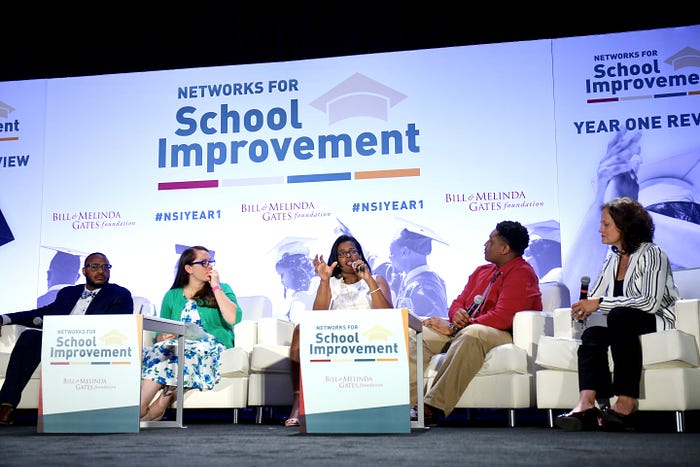How do we improve outcomes for Black, Latino, and low-income students — helping them to graduate high school and persist in earning a degree or credential that opens doors to good jobs and career paths? The question remains the central touchstone of the Gates Foundation’s work in education for more than 15 years and is rooted in our belief that all lives have equal value. And yet, even now, data shows we remain at the beginning of this journey and too many students are left behind.
Fifteen months ago, we launched a new group of investments focused on creating Networks for School Improvement (NSI). Across the country, networks of middle and high schools are working together to solve common problems using continuous improvement and support the success of Black, Latino, and low-income students.
On July 16, we held the Networks for School Improvement: Year One Review event at the University of Maryland, College Park. The event, which you can watch here, brought together more than 320 NSI practitioners, other educators, and community members now working with 298 schools and 250,000 students across the country to discuss early learning together.
Here are some of the early general lessons that participants described in panels, table discussions and speaker sessions:
- Schools need basic systems — strong leadership, strong instructional systems, ongoing youth engagement, to name a few — but there is no single answer to the work of optimizing these systems across large numbers of different schools. Given how highly varied schools are, with different cultures, governance structures, responsibilities and challenges, educators have the freedom to take research-based solutions and adapt them to the needs of their students, always checking for impact on student success.
- Continuous improvement holds the promise of strengthening existing reform efforts and identify new strategies and tools to further enhance this work. NSIs use data — things like attendance, course selection, and college applications — to “see the system” and really understand its shortcomings — the root cause of challenges to individual students and their success in school. This is hard but critical to spend time on and get right.
- The needs of individual students, and their experiences in classrooms or programs, need to be the center of this work. Grantees are overwhelmingly using surveys and empathy interviews to capture student voice and gain better understanding of their needs. Listening can be critical to challenge adults’ assumptions about student needs and their experience. But participants wondered if we could do more to include students and communities directly in the continuous improvement process.
- Choosing to measure strategies against high-leverage, predictive measures of student success appears to be a promising way of entering the work. These include (together with research base): 8th and 9th grade on-track; college readiness on-track; well-matched postsecondary enrollment; and postsecondary momentum. You can find these in our P-16 Framework.

Of course, one of the pleasures (and privileges) of the NSI gathering was hearing directly from practitioners in the field. Just as in schools, any abstract discussion of continuous improvement misses its excitement, complexity and potential impact in place. At the conference, educators described how continuous improvement, coupled with a deep commitment to addressing the needs of Black, Latino and low-income students, is showing signs of promise.
- “Engaging in continuous improvement for Black, Latinx students meant we had to dig deep into the data while holding the identities of the kids and families we are hoping to serve,” Tracy Fray-Oliver stated. She described her experiences with Bank Street College of Education’s partnership with Yonkers Public Schools to create interventions to address inequitable student math outcomes by analyzing data to track student improvement, facilitating inter-school collaboration, and conducting district-level planning meetings and school-level leadership training.
- “Listening to voices other than our own caused the entire Dallas/Pitt team to think, engage respond differently,” Dr. Rosa Apodaca, executive director of the Institute for Literacy (IFL)explained to the group.In partnership with Dallas Independent School District and the University of Pittsburgh’s Center for Urban Education and the Learning Research and Development Center, IFL is supporting 14 secondary schools to use continuous improvement to increase the English Language Arts proficiency among African-American, Latino and low-income students to ensure more are on track at the end of 9th grade and are positioned to graduate. She shared how the empathy interviews between teachers and students, and teachers and administrators, “were extremely powerful, they moved the hearts and minds of those who were conducting the interviews. Improvement science became very personal.
- “The promise [of CI] from a districtwide standpoint,” Baltimore City Schools Chancellor Sonja Santelises suggested, “is that there is finally opportunity to make sure that the whole system is aligned… It’s not just something the schools do, not just what the district office does, but something we all do… within the frame of equity. With a continuous improvement frame, it makes it more difficult to get set in your ways, and it makes it easier to give opportunity to aspiring leaders to really show they are improving practice.”Baltimore City Public Schools and the Carnegie Foundation for the Advancement of Teaching have partnered with a network of 14 district schools. There educators are using continuous improvement to inform the implementation of rigorous and engaging curriculum to improve literacy outcomes for students.
These are the early days for NSIs. In partnership with grantees and the larger field, we will continue to learn how the strategy works and where more needs to be done in context. Like our partners, we are committed to continuous improvement in our own practice. We believe that working together, we can gain a better collective understanding of what success looks like in place and across the nation.
To our NSIs — thanks for all the hard work. What will happen in Year 2? Stay tuned!
To learn more, please read our NSI: Year One report.
This post was reprinted from Medium.



